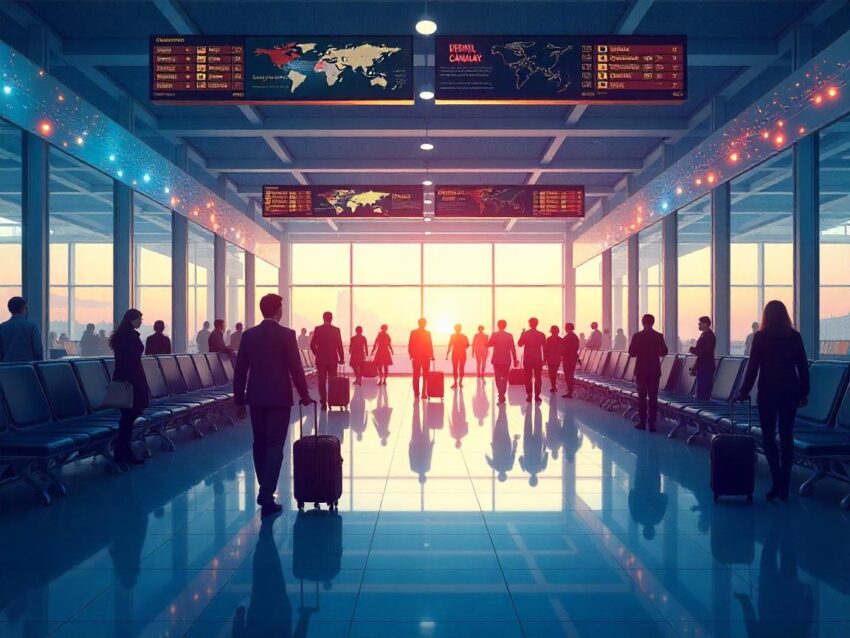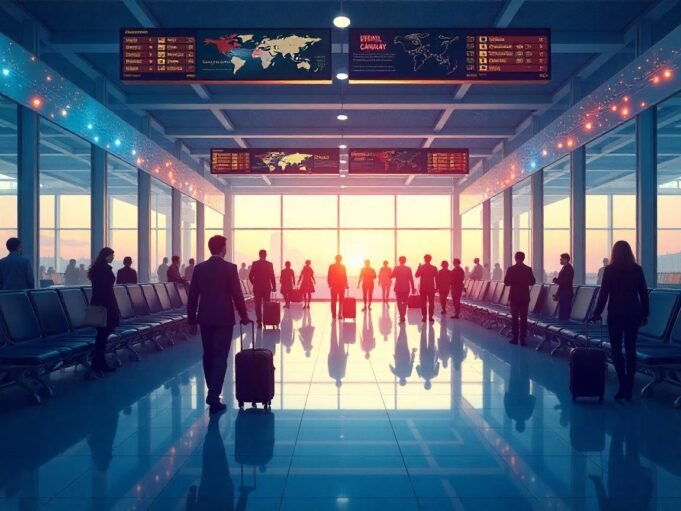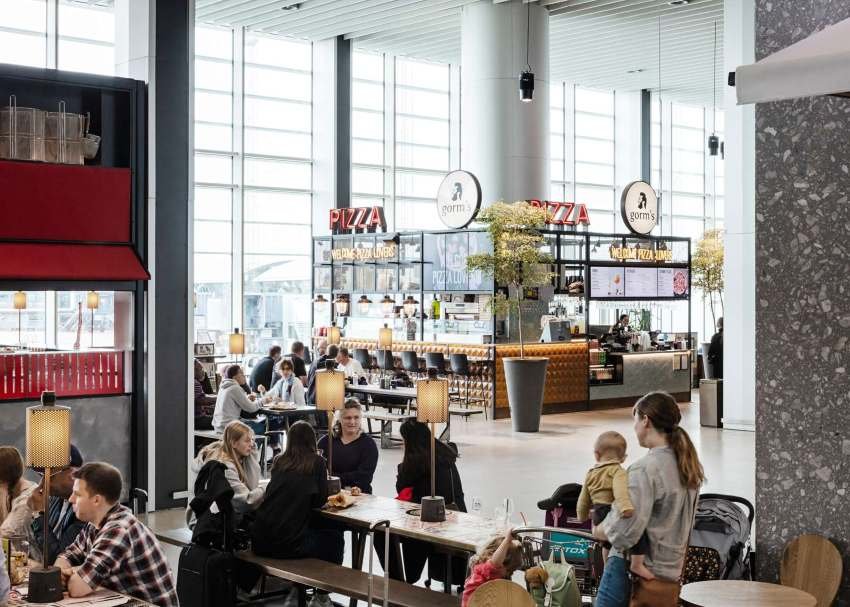Tuesday, July 1, 2025

Now, Atlanta joins Dallas-Fort Worth, Denver, Los Angeles, Chicago O’Hare, John F. Kennedy, and San Francisco in a bold move that’s shaking up travel maps everywhere. These US airports are transforming into busy hubs, connecting America’s Independence Day travel with Germany, Spain, Italy, and Canada.
Meanwhile, passenger numbers surge as travelers chase fireworks and faraway horizons. However, questions swirl in the air. Why is Atlanta stepping up now? How are Dallas-Fort Worth, Denver, Los Angeles, Chicago O’Hare, John F. Kennedy, and San Francisco fueling this colossal movement?
Moreover, the thrill of Independence Day travel mixes with the allure of Germany, Spain, Italy, and Canada, creating routes buzzing with new possibilities. Busy hubs become gateways not just for America but for global dreams.
A new update you need to know is here. And it’s rewriting how Atlanta and its airport allies connect America with the world. Buckle up—the skies are about to change.
A Nation on the Move—and On Edge
America’s love affair with travel never burns brighter than over the July 4 holiday. Fireworks light the skies, barbecues sizzle, and highways churn with road-trippers headed for beaches, mountains, and family reunions.
However, this year’s Independence Day is poised to test travelers like never before. Across the nation, airports are bracing for record-breaking passenger volumes, with Pittsburgh International Airport (PIT) squarely in the storm’s path.
Moreover, as the US Transportation Security Administration (TSA) braces to screen over 18.5 million travelers nationwide between July 1 and July 7, the reality is unavoidable: crowds, long lines, and potential chaos await those unprepared.
Why July 6 Is the Day to Watch
Travelers flying in or out of Pittsburgh should circle one date in red on their calendars: Sunday, July 6.
That day alone could see 2.9 million air travelers nationwide, making it the single busiest air travel day in Independence Day history. Meanwhile, PIT anticipates about 258,000 travelers flowing through its terminals during the holiday week, with the biggest surge also expected on July 6.
These numbers aren’t just statistics. They translate into longer waits at ticket counters, crowded security lanes, and full airport parking lots. Travelers arriving late risk missing flights. Tempers could flare in the queues.
However, knowledge is power—and a bit of planning can transform a stressful airport ordeal into a smooth, even enjoyable journey.
The Early Bird Wins: Timing Is Everything
The harsh truth? Peak stress hits Pittsburgh International Airport early in the day.
Between 5 a.m. and 8 a.m., PIT experiences its heaviest passenger flows. Lines snake around corners as travelers scramble to check bags, clear security, and rush to gates.
Meanwhile, the domino effect of early-morning congestion ripples throughout the day. Delays build. Crowds swell. Travelers arriving mid-morning may find themselves caught in chaos leftover from earlier waves.
As a result, leaving home earlier than usual is your secret weapon. Even a 30-minute head start could spare you from monumental stress.
Plan Parking Like a Pro
Another hidden challenge looms outside the terminal: airport parking.
Pittsburgh International urges travelers to secure parking ahead of time. Demand surges during holiday periods, and lots fill quickly.
Check Your Flight Status Obsessively
Even if Pittsburgh skies look clear, your flight’s fate could hinge on weather elsewhere.
Storm systems brewing across the Midwest, Northeast, or Gulf Coast can ripple through airline networks, triggering delays or cancellations far from the actual storm zone.
Moreover, the domino effect is real. A delayed inbound plane could derail your outbound schedule.
In the volatile landscape of holiday travel, information equals freedom. Stay vigilant.
The TSA Tango: Master the Security Game
If you’re flying during the July 4 rush, security screening is your Everest.
TSA officers will process more travelers this year than at any point in recent history. Lines will expand, especially early mornings and Sundays.
However, you can reduce stress dramatically with simple prep:
- Confirm that your carry-on bags meet TSA requirements. Prohibited items cause delays for you—and everyone behind you.
- Pack liquids in containers under 3.4 ounces and store them in a clear zip-top bag.
- Wear shoes that slip on and off easily to speed your passage through checkpoints.
- Keep electronics and your ID easily accessible.
Moreover, remember the REAL ID mandate. Travelers without a REAL ID or alternate ID, such as a passport, risk denied boarding. Don’t become the cautionary tale of the security line.
The Road to the Airport May Be a Gauntlet
While aviation headlines steal attention, ground transportation poses another headache.
AAA predicts a staggering 72.2 million Americans will travel at least 50 miles from home during the Independence Day period. Highways leading to airports like PIT will pulse with traffic.
Moreover, early-morning fliers must account for congested roads, construction zones, and unexpected delays.
As a result, allocate extra time for the drive. Arriving two hours before departure is the bare minimum during peak holidays. Three hours provides a safer cushion.
A Surge That Ripples Through the Industry
This record-breaking holiday period doesn’t just impact travelers—it reverberates across the entire travel industry.
Airlines face massive operational pressure to maintain schedules. Crews stretch to meet demand, and any disruption can cascade into delays nationwide.
Meanwhile, airports like PIT grapple with logistical puzzles: staffing enough security lanes, managing parking capacity, and keeping passengers informed.
Moreover, these spikes shape airline strategies for the future. Carriers analyze passenger flows to refine schedules, add new routes, or invest in airport upgrades. The July 4 surge becomes a powerful indicator of travel trends shaping the rest of the year.
The Emotional Toll—and Triumph—of Holiday Travel
For many, July 4 travel is about more than reaching a destination. It’s reunions with family. Fireworks under summer skies. Barbecues with friends unseen for too long.
However, the journey can strain even seasoned travelers. Frustration boils in security lines. Kids grow restless. Flight delays stir anxiety.
Yet amid the chaos, moments of human connection shine through. Airport staff offering smiles. Strangers helping each other lift bags. The shared understanding that we’re all chasing memories worth the hassle.
Your Playbook for Stress-Free Travel
As Pittsburgh and the nation brace for record numbers, here’s how to keep your July 4 travel smooth:
- Book parking early.
- Check your flight obsessively.
- Arrive earlier than you think necessary.
- Know TSA rules to avoid delays.
- Carry proper ID.
- Stay flexible and patient.
The Journey Continues
July 4 travel in 2025 is more than numbers on a TSA screen. It’s a vivid tapestry of movement, anticipation, and human spirit. Pittsburgh International Airport, like airports nationwide, stands ready for the challenge.
For travelers, the road may be bumpy—but the destination promises fireworks, freedom, and the joy that makes it all worthwhile.
America’s Airport Titans: How Nation’s Busiest Hubs Shape the Future of Travel, Tourism, and Economic Power
America’s airport titans are more than just terminals and tarmacs—they’re the living pulse of a nation constantly in motion. These bustling hubs connect families, fuel business empires, and keep the lifeblood of tourism flowing coast to coast.
Meanwhile, from Atlanta’s endless concourses to the neon glow of Las Vegas runways, each airport tells a story of ambition, resilience, and the unstoppable urge to explore. They’re places where tears mix with laughter, where goodbyes turn into new beginnings, and where millions navigate the delicate dance of travel every day.
However, these giants aren’t just moving people—they’re reshaping the very future of how America travels, trades, and grows. They’re economic powerhouses, innovation labs, and cultural crossroads rolled into one.
Moreover, as skies grow busier and travelers crave new experiences, the role of America’s busiest hubs has never been more crucial—or more fascinating. The journey begins right here.
A Sky Full of Giants
Step into any major U.S. airport, and you’ll feel it instantly: the pulse, the energy, the sheer choreography of millions of people moving in sync. Airports aren’t just transportation hubs—they’re the beating hearts of the American travel industry.
Yet some airports stand apart as titans, handling staggering numbers of passengers, connecting continents, and driving local economies. As America’s love for travel continues to surge, these airports don’t just move people; they shape the very future of tourism and business across the nation.
Let’s dive into the airports that keep the skies buzzing—and discover why they matter more than ever.
Atlanta’s Hartsfield-Jackson: The Global Connector
No list of aviation heavyweights begins anywhere but Hartsfield-Jackson Atlanta International Airport (ATL).
Every year, more than 100 million travelers pass through Atlanta’s concourses, making it the busiest airport on Earth. It’s the central nervous system of Delta Air Lines, connecting flights from small American towns to distant international cities.
But ATL is more than numbers. Its efficiency and near-perfect on-time rates make it a model in the industry. When travelers transit through Atlanta, they experience a well-oiled machine of moving walkways, food courts, and endless gates.
Moreover, ATL isn’t just vital for travelers—it’s a massive economic driver, supporting tens of thousands of jobs and injecting billions into Georgia’s economy.
Dallas-Fort Worth: The Crossroads of America
Move west and you’ll find Dallas/Fort Worth International Airport (DFW), another titan in the skies.
Handling around 81 million passengers yearly, DFW sprawls across five terminals and more than 26 square miles. It’s one of the few airports big enough to have its own ZIP code!
DFW is the powerhouse of American Airlines, serving as a crucial connector between the East and West Coasts and offering robust flights into Latin America and Asia.
However, it’s not just size that matters. DFW’s continued expansion reflects Texas’s booming economy and the region’s growing influence in global business and tourism.
Denver International: Gateway to the Rockies
At the foot of the Rocky Mountains lies Denver International Airport (DEN)—an airport famous for its soaring white-tented roof, which mimics snow-capped peaks.
With roughly 78 million travelers, DEN has become a must-pass-through hub. It’s perfect for connecting flights between coasts and serves as a major base for United, Southwest, and Frontier Airlines.
Moreover, DEN is the second-largest airport in the world by land area. Its size allows room for new runways and terminals, making it a future-proof hub as air travel demand explodes.
Denver’s airport is more than a transit point—it’s a gateway to Colorado’s thriving ski industry and outdoor tourism, drawing visitors year-round.
Los Angeles International: Hollywood’s Gateway
Los Angeles International Airport (LAX) is iconic. It’s a place where celebrities dash through private terminals while tourists snap selfies under the giant “LAX” letters.
Handling 76 million passengers annually, LAX is the premier Pacific gateway for flights to Asia, Australia, and Latin America. For many international travelers, it’s their first glimpse of America.
Moreover, LAX fuels California’s $150+ billion tourism industry, feeding visitors into Hollywood, Disneyland, and national parks. It’s also undergoing massive renovations aimed at easing congestion and modernizing facilities.
LAX is where glamour meets grit, and the airport’s evolution mirrors LA’s role as a global cultural hub.
Chicago O’Hare: The Heartland Hub
Few airports have a reputation quite like Chicago O’Hare International Airport (ORD). For decades, O’Hare was the world’s busiest, and it remains a major U.S. connector.
Serving over 73 million travelers, ORD is a critical hub for both United and American Airlines. Its central location makes it perfect for connecting flights coast-to-coast or to Europe.
However, O’Hare also epitomizes the challenges of America’s aviation infrastructure. Frequent weather delays and crowded runways test even the savviest traveler’s patience.
Yet the airport continues to expand and modernize, reflecting Chicago’s status as a global city and economic powerhouse.
New York JFK: America’s Global Front Door
No airport screams international travel like John F. Kennedy International Airport (JFK).
With 62 million passengers, JFK is New York’s primary international gateway. It connects the U.S. to Europe, Africa, and the Middle East and serves as a key hub for Delta and JetBlue.
However, JFK is more than a transit hub—it’s part of New York’s identity. It’s where immigrants have landed, celebrities have flown in, and goods flow in and out of America’s busiest city.
Currently, JFK is undergoing a multi-billion-dollar redevelopment to expand terminals and improve the passenger experience, aiming to match its reputation as a world-class airport.
San Francisco: Gateway to Asia
San Francisco International Airport (SFO) is the Pacific bridge between North America and Asia.
With around 57 million travelers, SFO serves as a major hub for United and Alaska Airlines. It’s a crucial link for tech giants and tourists alike.
Moreover, SFO has become a leader in sustainability, boasting one of the world’s greenest airport terminals.
San Francisco’s airport is the perfect metaphor for the city itself: innovative, global, and ready for the future.
Las Vegas: Tourism’s Powerhouse
Harry Reid International Airport (LAS) in Las Vegas may not be the largest, but it’s a juggernaut for tourism.
With over 52 million passengers, LAS is fueled by conventions, entertainment, and the endless allure of the Strip.
Beyond the glitz, LAS is a critical gateway for domestic travel and increasingly connects to international destinations.
Las Vegas’s airport proves that tourism can transform a desert city into one of America’s busiest air corridors.
Miami International: Gateway to Latin America
Down in Florida, Miami International Airport (MIA) reigns as the U.S. hub for Latin America and the Caribbean.
Handling about 50 million passengers, MIA is American Airlines’ vital hub for connections to South America and Europe.
Moreover, MIA is essential for cargo, moving millions of tons of freight that support Florida’s vibrant economy.
It’s a multicultural gateway where languages blend and cultures collide, perfectly reflecting Miami’s global vibe.
Why These Airports Matter
These giants don’t just move people—they drive local economies, shape airline strategies, and influence how America connects with the world.
Moreover, they’re barometers for broader travel trends: sustainable design, post-pandemic resilience, and innovations that make flying faster and more efficient.
From the rain-soaked runways of Seattle to the sunlit expanses of Miami, America’s airports remain vital engines of commerce and tourism.
The Future of Flight
As passenger volumes climb toward new records, these airports face big questions. How to manage crowds? How to modernize aging infrastructure? And how to balance growth with sustainability?
Yet one thing is certain: America’s airport titans will continue to shape the future of travel, keeping the nation—and the world—on the move.
«Enjoyed this post? Never miss out on future posts by following us»











